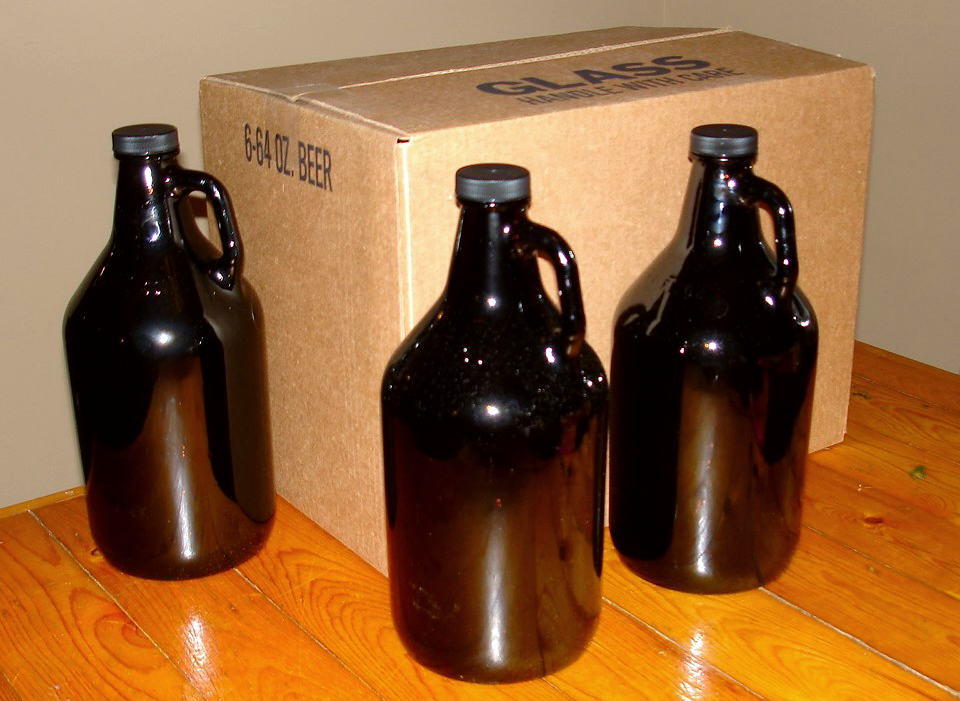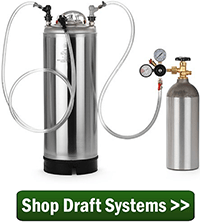 Most homebrewers that bottle their beer have probably figured out that the bigger the bottle, the fewer bottles you’ll have to fill. That’s why I like to hoard 22 oz. and 750mL beer bottles. It only takes about thirty 22 oz. bottles to bottle a five-gallon batch, compared to about fifty 12 oz. bottles. By extension, bottling beer in growlers should make things even easier, right?
Most homebrewers that bottle their beer have probably figured out that the bigger the bottle, the fewer bottles you’ll have to fill. That’s why I like to hoard 22 oz. and 750mL beer bottles. It only takes about thirty 22 oz. bottles to bottle a five-gallon batch, compared to about fifty 12 oz. bottles. By extension, bottling beer in growlers should make things even easier, right?
Not so fast. Bottle your beer in growlers, and you run the risk of one exploding!
Bottle conditioning works because yeast consumes priming sugar to create CO2. Since the bottle is capped, the CO2 has nowhere to go but into suspension, thereby carbonating the beer.
This CO2 creates pressure inside the bottle. Regular beer bottles are designed to withstand that pressure, but most growlers are not. Just take a look at a growler and you can see that the glass is relatively thin compared to a normal beer bottle. Growlers are made for transporting beer that has already been carbonated. While there is some pressure in growlers fill with draft beer, it’s nothing compared to the 30 or 35 pounds of pressure that is typically created during bottle conditioning. Bottle been in growlers, and they could explode on you.
I’m sad to say it’s happened to me twice, and I haven’t bottled in a growler since. If it’s happened to you, you’ll agree that it’s worth spending a few extra minutes cleaning and sanitizing a few extra bottles to avoid losing a half-gallon of beer. Cleaning up that much beer is not fun – especially when you could be drinking it instead!
 This isn’t to say that no one has ever successfully bottle conditioned their beer in a growler. I’m sure there are homebrewers out there who take the risk, and make sure to keep the temperature of the growler in check so it doesn’t go out of control. But for me, I’d rather just not deal with a stress of wondering, “Is today the day? Is that growler going to blow in my sleep?”
This isn’t to say that no one has ever successfully bottle conditioned their beer in a growler. I’m sure there are homebrewers out there who take the risk, and make sure to keep the temperature of the growler in check so it doesn’t go out of control. But for me, I’d rather just not deal with a stress of wondering, “Is today the day? Is that growler going to blow in my sleep?”
If you’ve reached the point where bottling is too tedious, I highly recommend investing in a homebrew keg system. Sure, the up front investment is higher than it is for bottling, but the saved labor is significant. Plus, you get to really dial in the carbonation of your beer by adjusting the pressure on the CO2 regulator.
Have you ever tried bottling beer in growlers? Were you successful? Or do you have a broken glass horror story to share?
———————————–
David Ackley is a writer, brewer, and craft beer marketing consultant. He holds a General Certificate in Brewing from the Institute of Brewing and Distilling and is founder of the Local Beer Blog.

I bought 6 growlers from Amazon specifically rated safe for home brewing. The lids are reinforced and the glass is thicker. These growlers are heavy duty. Is this type of growler safe to ferment in?
Fermenting will be fine in them. I do not know that I would try and carbonate in them. The carbonation may create too much pressure causing the growler to explode.
Cheers!
Jason
Hey AIH, the conclusion is correct, but the rationale is patently false (that 30-35 psi is created in bottle conditioning and growlers can’t handle that). A typical American ale carbonated to 2.5 volumes and stored in a growler at room temp (70°F/21°C) will be at 30-31 psi as per the ASBC chart for solubility of CO2 in beer. Heck, you can let that beer get up to 30°C/86°F in your car (43-43 psi) and it’s not going to explode.
Furthermore, the false mental model of bottle conditioning creating an overpressure as if you were force carbonating a beer using the burst carbonation method is just that – false. Manometer readings disprove that, and a few seconds of thought makes one quickly realize that in bottle conditioining, the CO2 is created by yeast on molecule-by-molecule basis drectly in the beer and it dissolves instantly. Yes, due to the high levels of particulates and warm temps, some CO2 breaks out of solution, goes to the headspace creating 2-3 psi overpressure, and is later dissolved back in the beer to reach equilibrium. Again, this has been verifed measured by manometer. But this overpressure effect is tiny and not meaningful.
The only reason not to bottle condition in glass growlers is the mutiple ways even experienced homebrewers can mess up and get massive overpressure. Industry standard bottles just have more glass/volume and better geometry in terms of provding a margin of safety.
Let’s set the record straight. Cheers and keep up the good work otherwise!